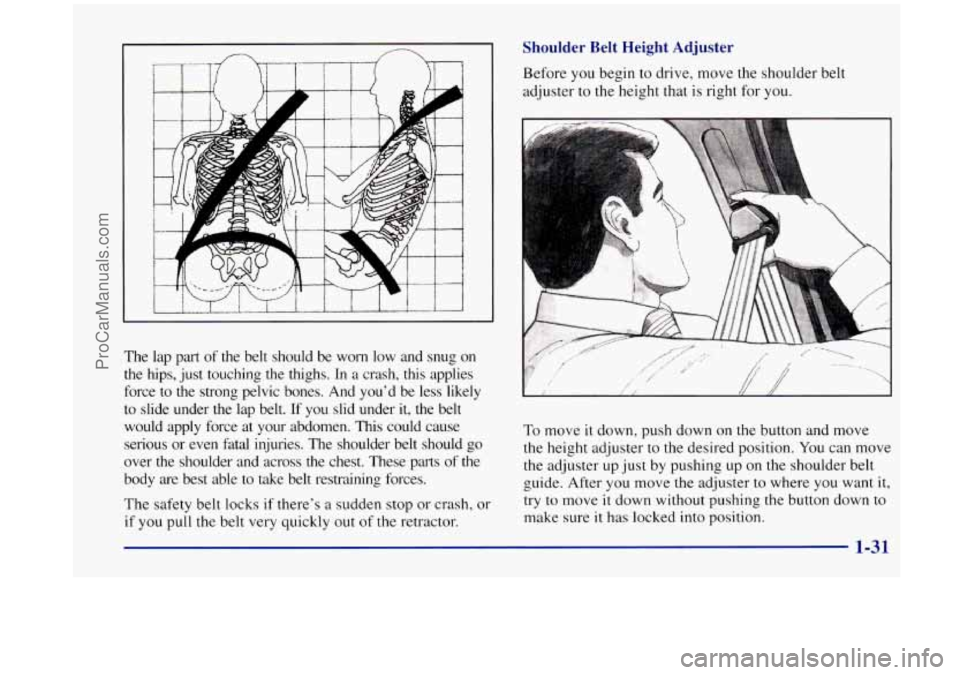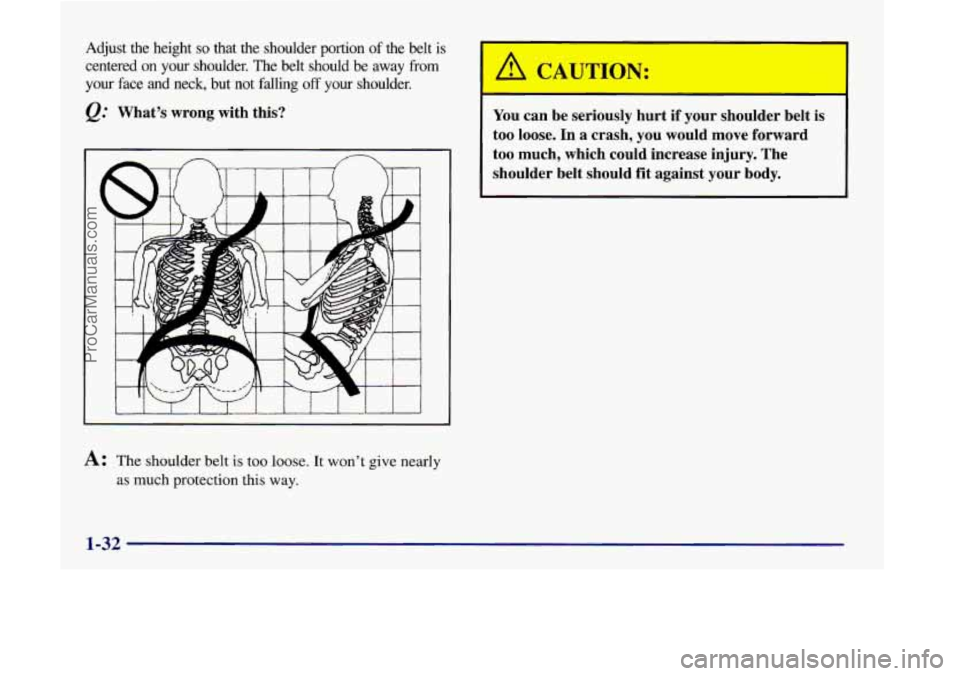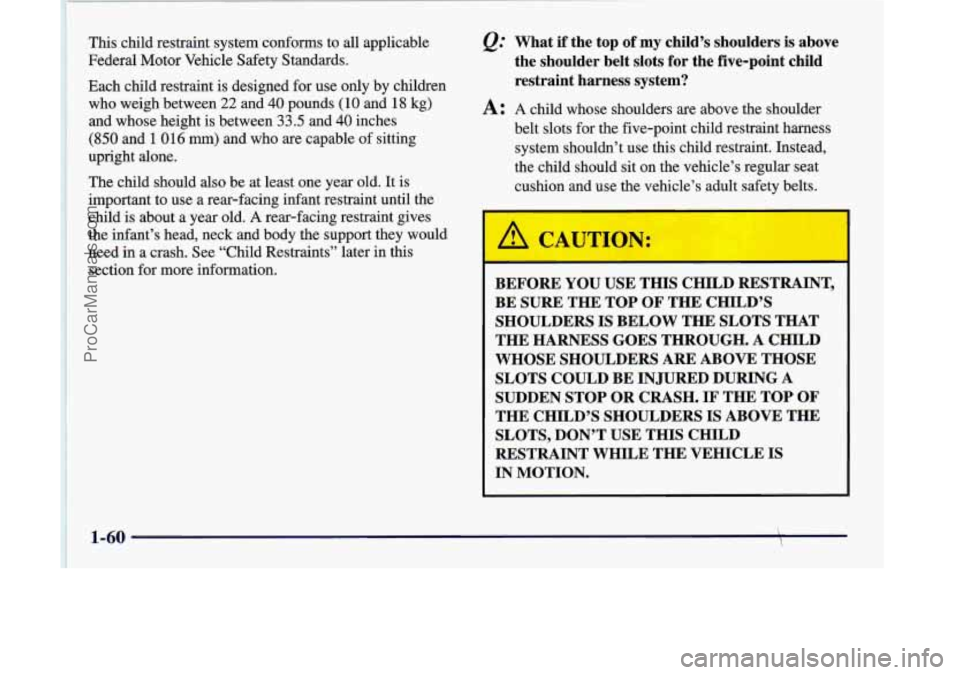1998 OLDSMOBILE SILHOUETTE height
[x] Cancel search: heightPage 43 of 444

The lap part of the belt should be worn low and snug on
the hips, just touching
the thighs. In a crash, this applies
force to the strong pelvic bones. And you'd be less likely
to slide under the lap belt. If you slid under it, the belt
would apply force at your abdomen. This could cause
serious or even fatal injuries. The shoulder belt should
go
over the shoulder and across the chest. These parts of the
body are best able to take belt restraining forces.
The safety belt locks if there's a sudden stop or crash, or
if you pull the belt very quickly out of the retractor.
Shoulder Belt Height Adjuster
Before you begin to drive, move the shoulder belt
adjuster
to the height that is right for you.
To move it down, push down on the button and move
the height adjuster to the desired position. You can move
the adjuster up just by pushing up on the shoulder belt
guide. After
you move the adjuster to where you want it,
try to move it down without pushing the button down to
make sure it has locked into position.
ProCarManuals.com
Page 44 of 444

Adjust the height so that the shoulder portion of the belt is
centered on your shoulder. The belt should be away
from
your face and neck, but not falling off your shoulder.
&: What's wrong with this?
1 I I 1 I 1 i I i I I
A: The shoulder belt is too loose. It won't give nearly
as much protection this way.
You can be seriously hurt if your shoulder belt is
too loose. In a crash, you would move forward
too much, which could increase injury. The
shoulder belt should fit against your body.
1-32
ProCarManuals.com
Page 72 of 444

This child restraint system conforms to all applicable
Federal Motor Vehicle Safety Standards.
Each child restraint is designed for use only by children
who weigh between
22 and 40 pounds (10 and 18 kg)
and whose height is between 33.5 and 40 inches
(850 and 1 016 mm) and who are capable of sitting
upright alone.
The child should
also be at least one year old. It is
important to use a rear-facing infant restraint until the
child is about a year old.
A rex-facing restraint gives
the infant’s head, neck and body the support they would
need in a crash. See “Child Restraints” later in this
section for more information.
&: What if the top of my child’s shoulders is above
the shoulder belt slots for the five-point child
restraint harness system?
A: A child whose shoulders are above the shoulder
belt slots for the five-point child restraint harness
system shouldn’t use
this child restraint. Instead,
the child should sit
on the vehicle’s regular seat
cushion and use the vehicle’s adult safety belts.
BEFORE YOU USE THIS CHILD RESTRAINT,
BE SURE THE TOP
OF THE CHILD’S
SHOULDERS
IS BELOW THE SLOTS THAT
THE HARNESS GOES THROUGH.
A CHILD
WHOSE SHOULDERS ARE ABOVE THOSE
SLOTS COULD BE INJURED DURING
A
SUDDEN STOP OR CRASH. IF THE TOP OF
THE CHILD’S SHOULDERS IS ABOVE THE
SLOTS, DON’T USE
THIS CHILD
RESTRAINT WHILE THE VEHICLE
IS
IN MOTION.
1-60
ProCarManuals.com
Page 85 of 444

A forward-facing child restraint (C-E) positions a
child upright to face forward in the vehicle. These
forward-facing restraints are designed to help
protect children who are
from 20 to 40 lbs.
(9 to 18 kg) and about 26 to 40 inches (66 to
102 cm) in height, or up to around four years of
age. One type, a convertible restraint, is designed to
be used either as a rear-facing infant seat or a
forward-facing child seat.
1-73
ProCarManuals.com
Page 339 of 444

Brake Wear
Your vehicle has front disc brakes and rear drum brakes.
Disc brake pads have built-in wear indicators that
make a high-pitched warning sound when the brake
pads are worn and new pads are needed. The sound may
come and go or be heard all the time your vehicle is
moving (except when you are pushing
on the brake
pedal firmly).
I A CAUTION:
The brake wear warning sound means that soon
your brakes won’t work well. That could lead to
an accident. When you hear the brake wear
warning sound, have your vehicle serviced.
NOTICE:
Continuing to drive with worn-out brake pads
could result in costly brake repair.
Some driving conditions or climates may cause a brake
squeal when the brakes are first applied
or lightly
applied. This does not mean something is wrong with
your brakes.
Properly torqued wheel nuts are necessary to help
prevent brake pulsation. When tires are rotated, inspect
brake pads for wear and evenly torque wheel nuts in
the proper sequence
to GM specifications.
Your rear drum brakes don’t have wear indicators, but
if you ever hear
a rear brake rubbing noise, have the
rear brake linings inspected immediately. Also, the rear
brake drums should be removed and inspected each time
the tires are removed for rotation or changing. When
you have the front brake pads replaced, have the rear
brakes inspected, too.
Brake linings should always be replaced as complete
axle sets.
See “Brake System Inspection’’ in Section
7 under
Part
C “Periodic Maintenance Inspections.”
Brake Pedal Travel
See your retailer if the brake pedal does not return to
normal height, or if there is a rapid increase in pedal
travel. This could be a sign of brake trouble.
6-29
ProCarManuals.com
Page 355 of 444

Wheel Alignment and Tire Balance
The wheels on your vehicle were aligned and balanced
carefully at
the factory to give you the longest tire life
and best overall performance.
Scheduled wheel alignment and wheel balancing are
not needed. However, if you notice unusual tire wear or
your vehicle pulling one way or the other, the alignment
may need
to be reset. If you notice your vehicle
vibrating when driving on a smooth road, your wheels
may need to be rebalanced.
Wheel Replacement
Replace any wheel that is bent, cracked, or badly rusted
or corroded. If wheel nuts keep coming loose, the wheel,
wheel bolts and wheel nuts should be replaced.
If the
wheel leaks air, replace it (except some aluminum
wheels, which can sometimes be repaired). See your
retailer if any
of these conditions exist.
Your retailer will know the kind of wheel you need.
Each new wheel should have
the same load-carrying
capacity, diameter, width, offset and be mounted the
same way
as the one it replaces.
If you need to replace any of your wheels, wheel bolts
or wheel nuts, replace them only with new
GM original
equipment parts. This way,
you will be sure to have the right wheel, wheel bolts
and wheel nuts
for your
Oldsmobile model.
Using the wrong replacement wheels, wheel bolts
or wheel nuts on your vehicle can be dangerous.
It could affect the braking and handling of your
vehicle, make your tires lose air and make you
lose control. You could have
a collision in which
you or others could be injured. Always use the
correct wheel, wheel bolts and wheel nuts for
replacement.
NOTICE:
The wrong wheel can also cause problems with
bearing life, brake cooling, speedometer or
odometer calibration, headlamp aim, bumper
height, vehicle ground clearance and tire
or tire
chain clearance to the body and chassis.
See “Changing
a Flat Tire” in the Index for more
information.
6-45
ProCarManuals.com
Page 375 of 444

Vehicle Dimensions - Regular
Wheel Base
Length ................. 187.4 inches (475.9 cm)
Width
...................... 72 inches (183 cm)
Height
................... 67.4 inches (1 7 1.2 cm)
Wheelbase
................ 11 2 inches (284.5 cm)
Front Tread Width
......... 6 1.5 inches (1 56.2 cm)
Rear Tread Width
.......... 63.3 inches (1 60.8 cm)
Vehicle Dimensions - Extended
Wheel Base
Length ................. 20 1.4 inches (5 1 1.5 cm)
Width
................... 72.2 inches (183.4 cm)
Height
................... 68.1 inches (172.9 cm)
Wheelbase
................ 120 inches (304.7 cm)
Front Tread Width
......... 6 1.5 inches (156.2 cm)
Rear Tread Width
.......... 63.3 inches ( 160.8 cm)
Normal Maintenance
Replacement Parts
Air Cleaner Filter ............. AC Type A- 1208C
Passenger Compartment Air Cleaner Filter
(2) ............... 52470574
Engine Oil Filter
........................ PF47
Spark Plugs
................... AC Type 4 1-940
Gap: 0.060 inches (1.5 mm)
Windshield Wiper Blades
Length
..................... 24 inches (60 cm)
Type
......................... Shepard’s Hook
Length
.................... 16 inches (40.6 cm)
Type
......................... Shepard’s Hook
Backglass Wiper Blade
Air Conditioning Refrigerants
Not all air conditioning refrigerants are the same.
If the air conditioning system in your vehicle needs
refrigerant, be sure the proper refrigerant is used.
If
you’re not sure, ask your retailer.
6-65
ProCarManuals.com
Page 435 of 444

Replacing Bucketseats
................................. 1-19
Captain’s Chairs
.............................. 1-23
SafetyBelts
................................. 1-90
Split Bench Seat
............................... 1-12
Reporting Safety Defects
...................... 8-8. 8-9
Resetting the Power Sliding Door
.................. 2-19
Restraints Checking
................................... 1-89
Child
....................................... 1-70
Head
........................................ 1-6
Replacing Parts After a Crash
................... 1-90
Second Row Safety Belt Stowage
................. 1-7
Systemcheck
................................ 7-30
Restraint Systems. Supplemental (SRS)
............. 1-38
Reverse
....................................... 2-31
Right Front Passenger Position
.................... 1-38
Roadside Assistance
.............................. 8-5
Rocking
Your Vehicle ........................... 5-36
Rotation. Tires
................................. 6-41
Seat and Restraint System Parts After
a Crash
...... 1-90
safety Belt Extender
............................ 1-89
SafetyBelts
................................... 1-24
Adults
...................................... 1-29
Care
....................................... 6-49
Center Passenger Position (Bench Seat)
........... 1-53
Center Passenger Position (Bucket Seat)
........... 1-54
Children
.................................... 1-56
Driver Position
............................... 1-29
Extender
.................................... 1-89
How to Wear Properly
......................... 1-29
Incorrect Usage
.................... 1-32,l-87, 1-88 Lap
Belt
............................... 1.52. 1.54
Lap-Shoulder
........................... 1.29. 1.47
Larger Children
.............................. 1-86
Passenger Position
............................ 1-38
Questions and Answers
........................ 1-28
Rear
Comfort Guides .......................... 1-50
Rear Seat Outside Passenger Positions
............ 1-46
Rear Seat Passengers
.......................... 1-46
Reminder Light
......................... 1.25. 2.87
Right Front Passenger Position
.................. 1-38
Shoulder Belt Height Adjuster
................... 1-31
Smaller Children and Babies
.................... 1-56
WhyTheyWork
.............................. 1-25
SafetyChains
.................................. 4-37
Safety Defects. Reporting
..................... 8-8. 8-9
Safety Warnings and Symbols
....................... 1u
Scheduled Maintenance Services .................... 7-4
Seat Controls
............................... 1-2. 1-6
Seatback
Folding Driver’s
............................... 1-3
RecliningFront
............................... 1-4
Controls
................................. 1-2. 1-6
Driver’s Four-Way Manual
...................... 1-2
Dumpandstow
............................... 1-7
Lumbar Control
............................... 1-6
Manual Front Passenger
......................... 1-4
Power
....................................... 1-3
Rear
........................................ 1-6
Restraint Systems
.............................. 1-1
Seat Controls ................................. 1-2
Replacing After
a Crash
........................ 1-90
Use During Pregnancy
......................... 1-37
...
Seats
9-9
ProCarManuals.com